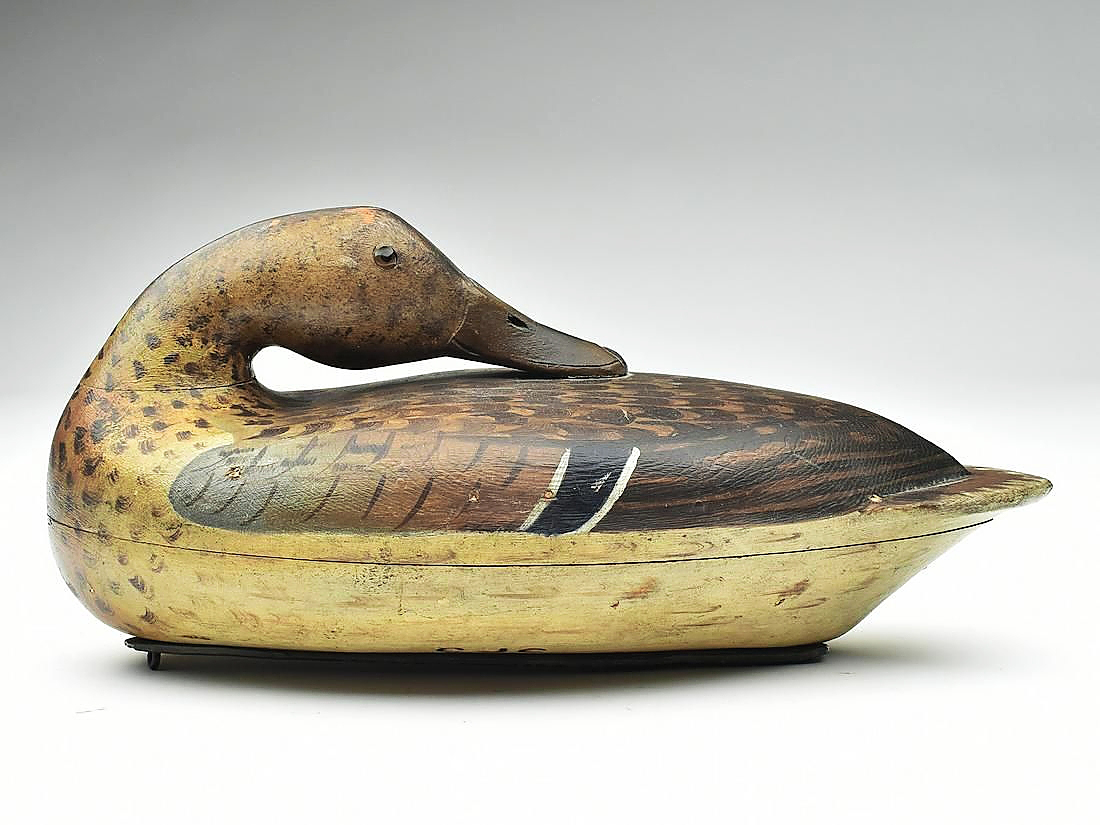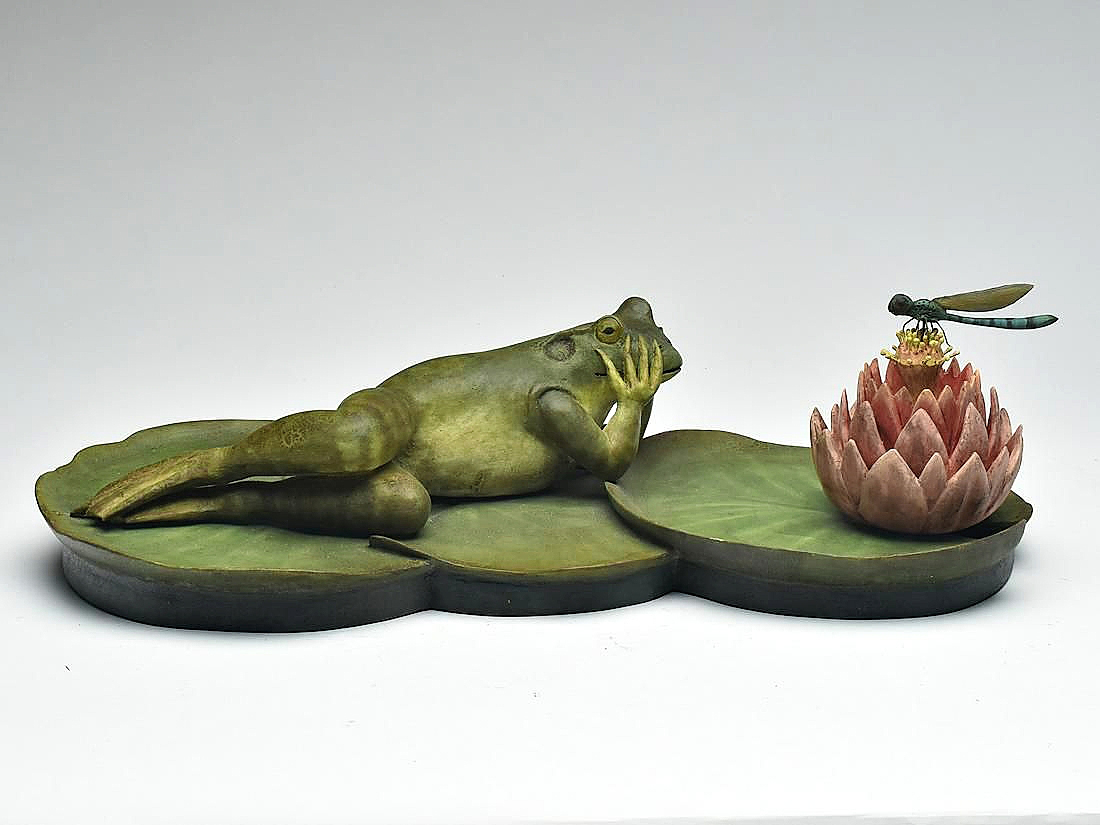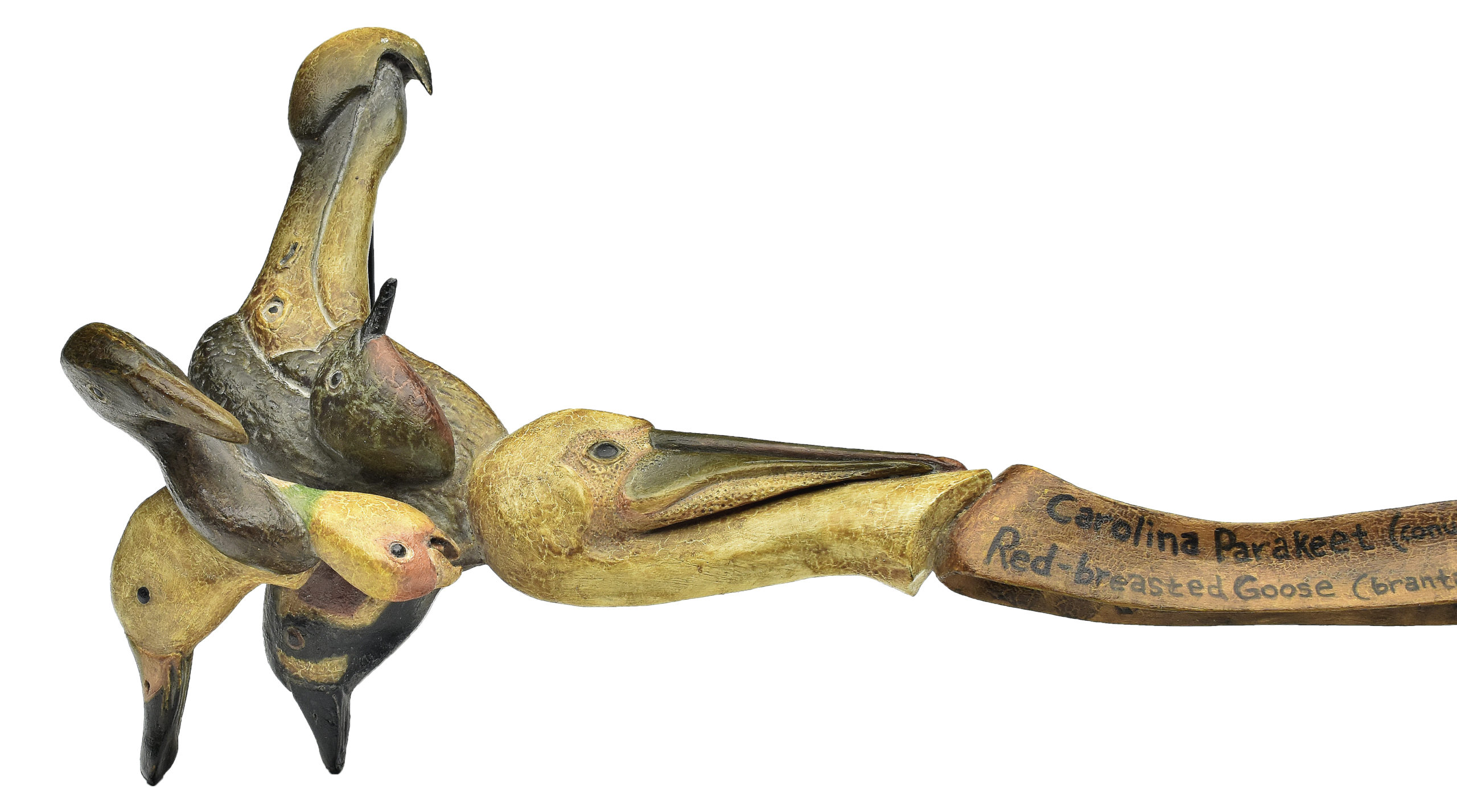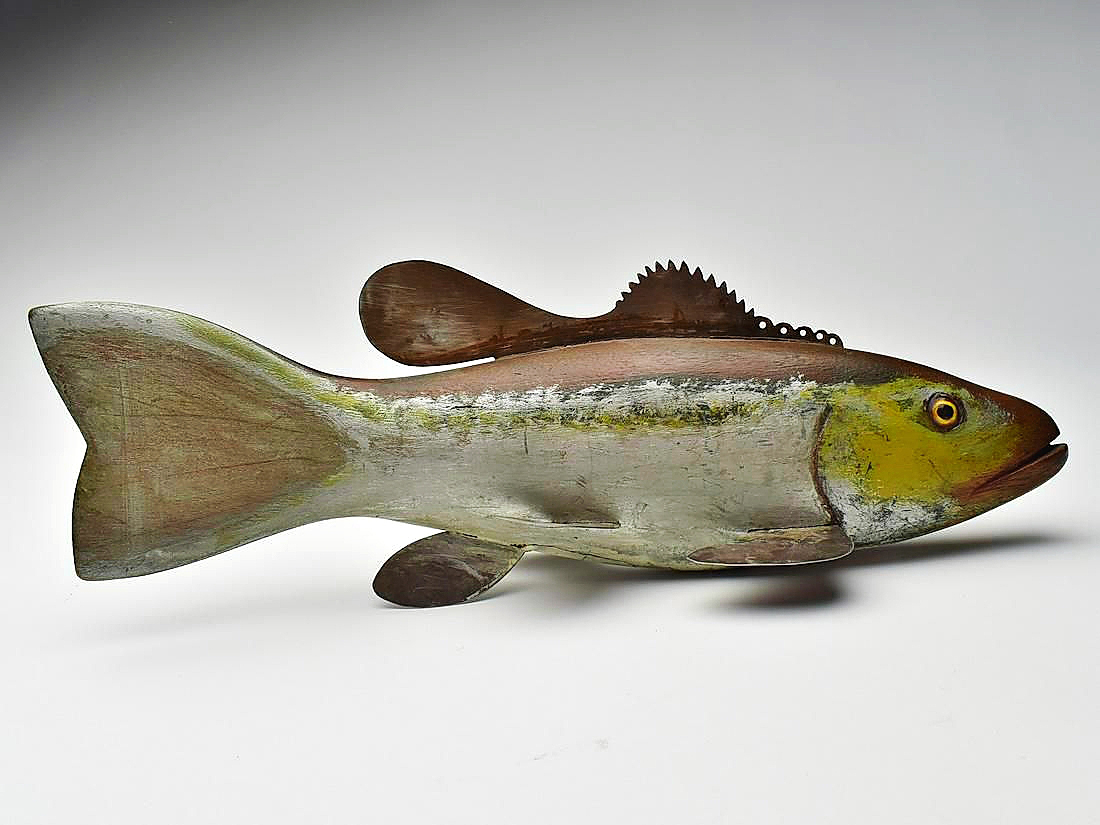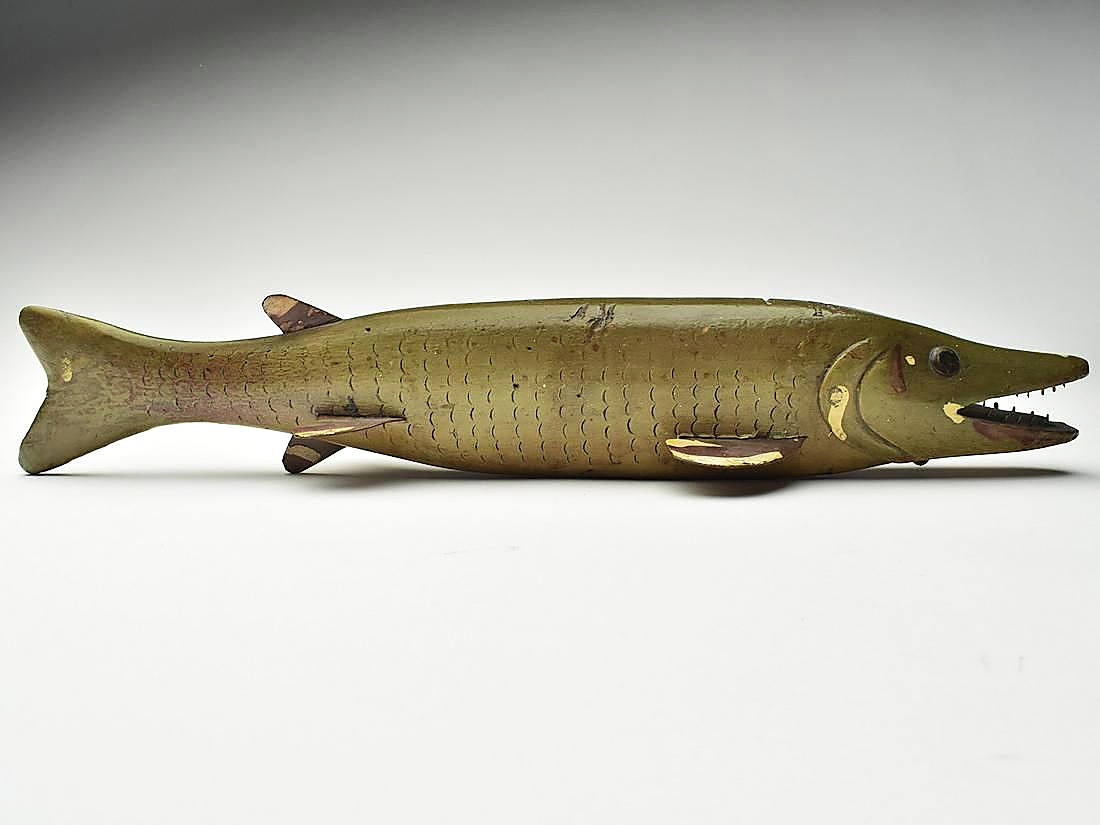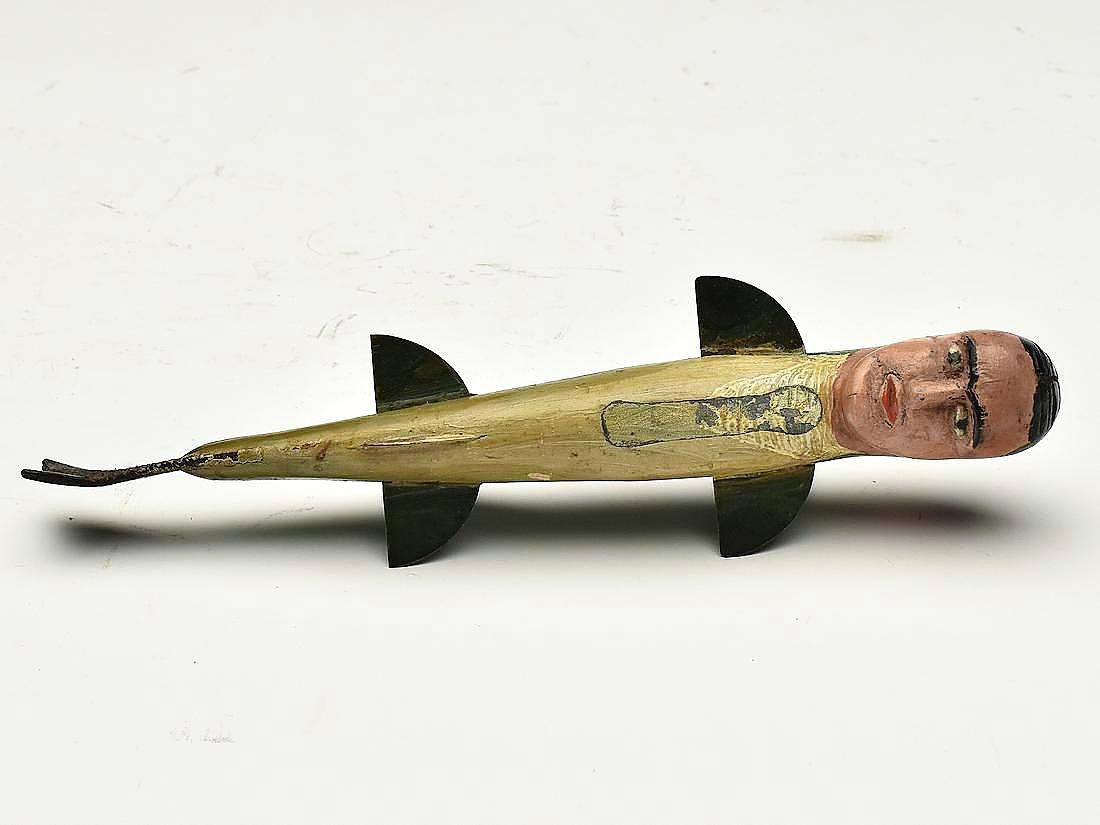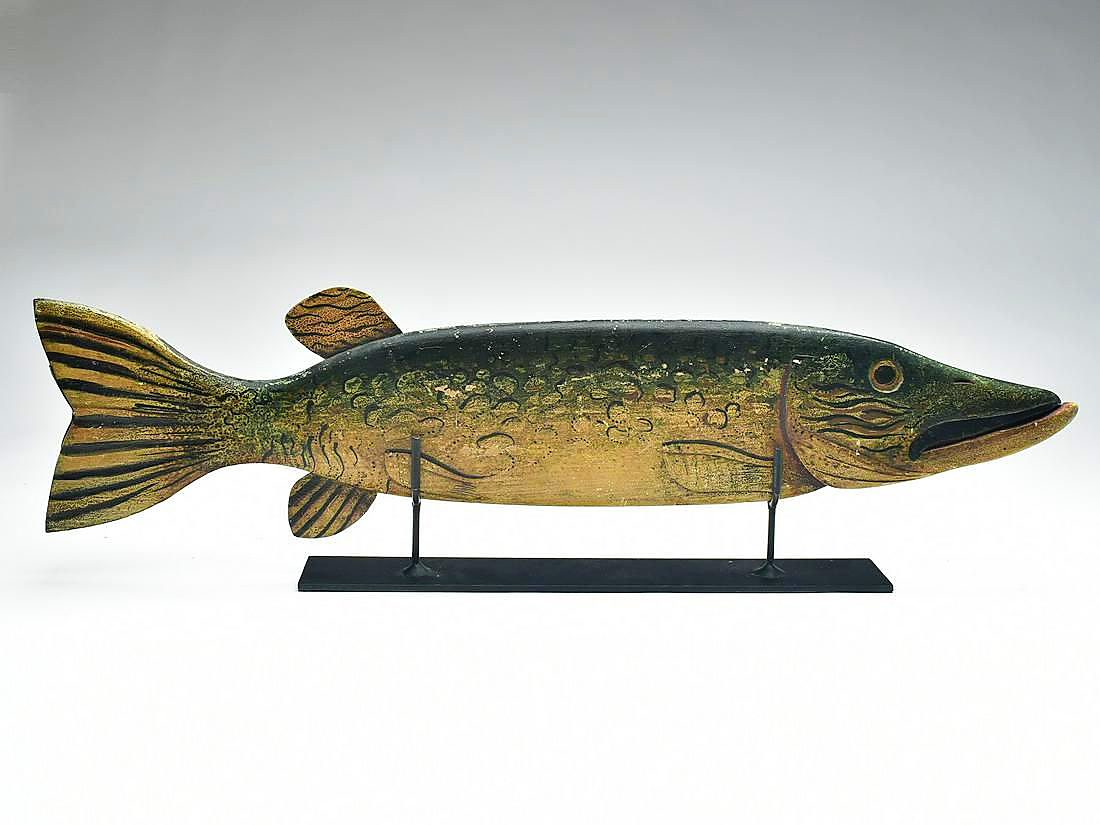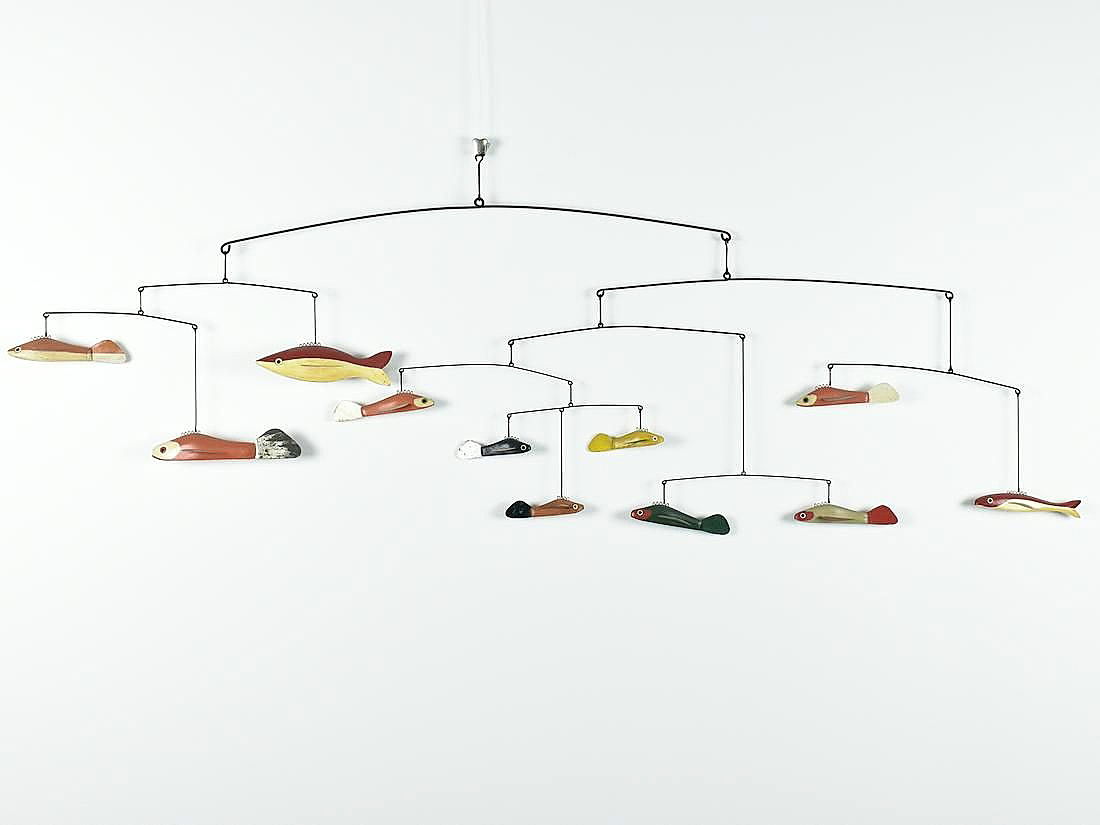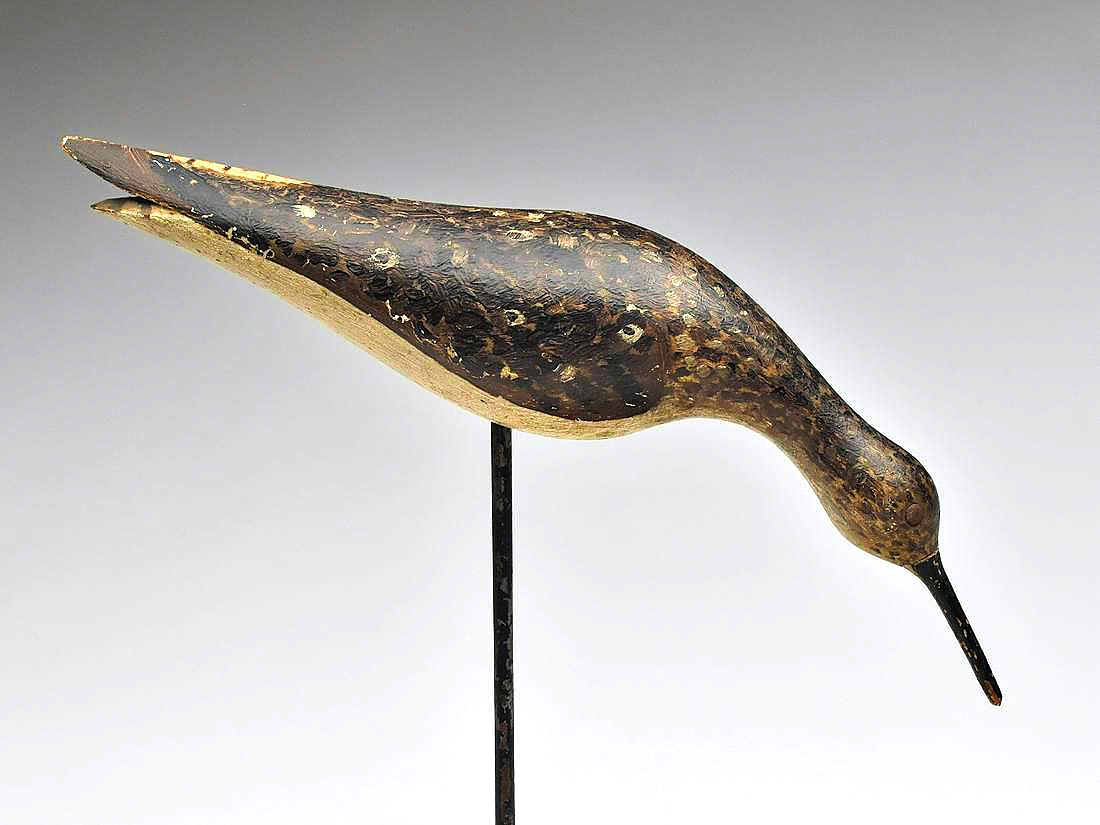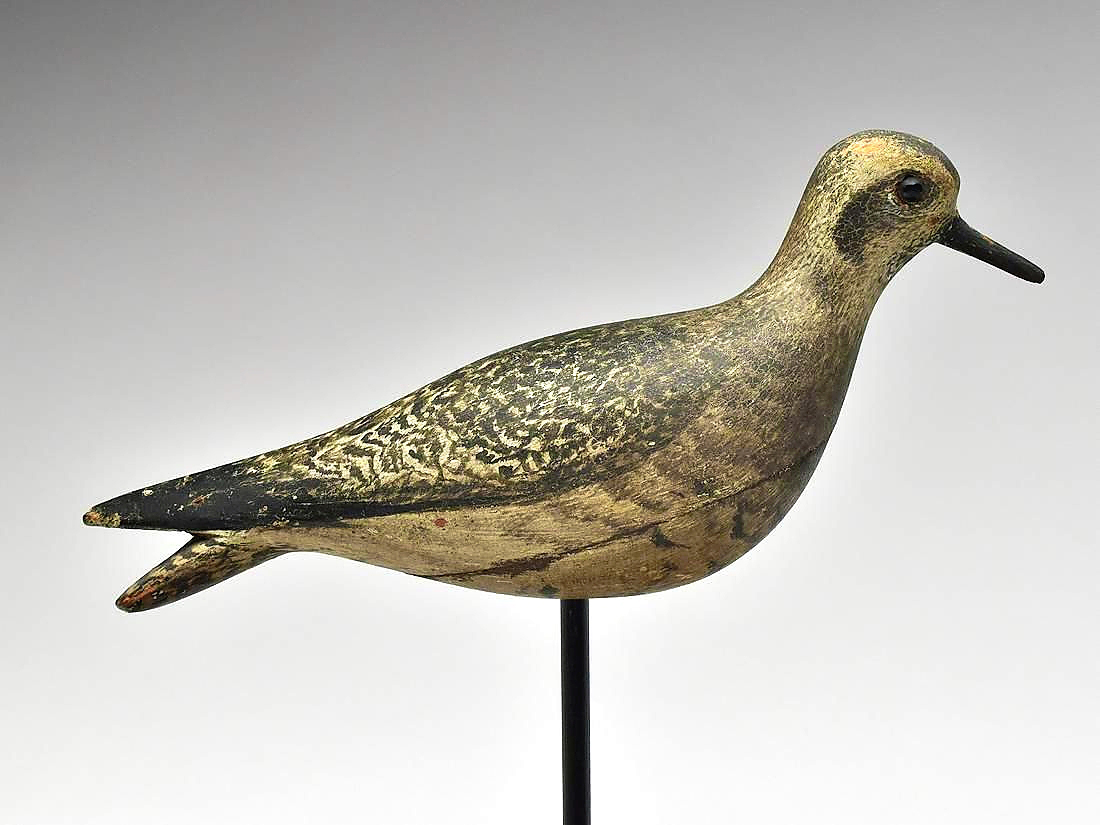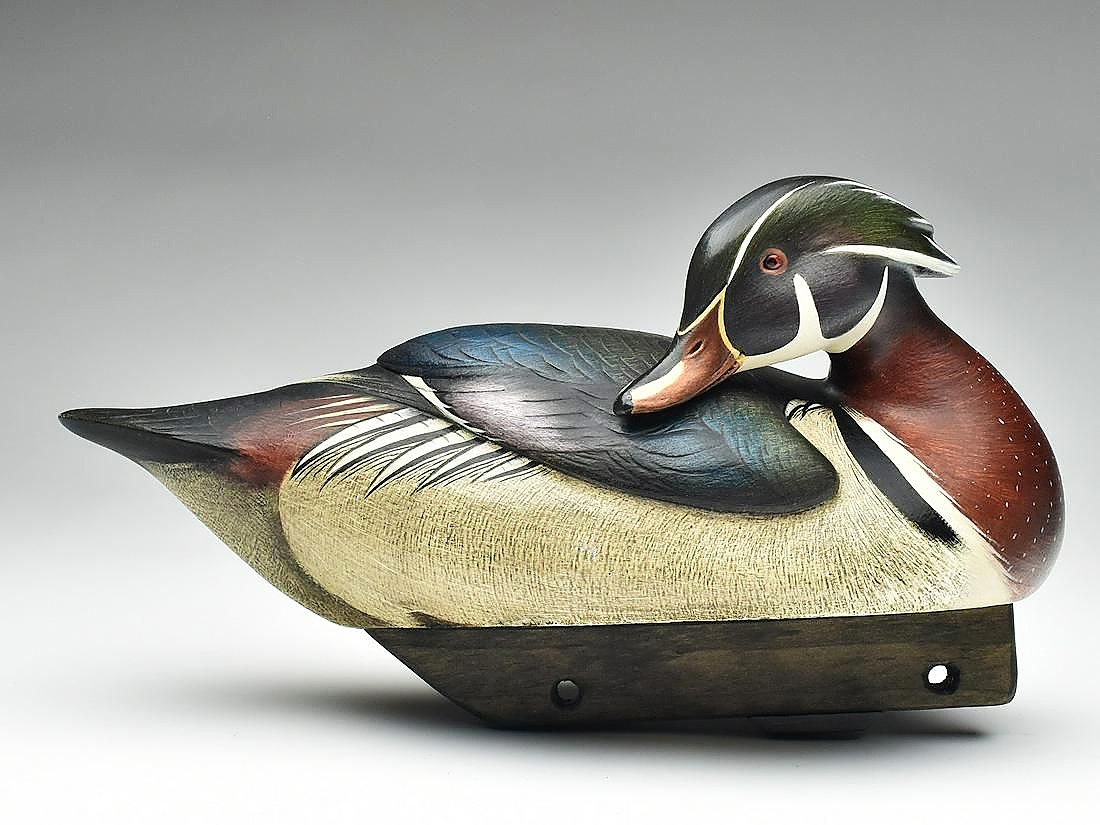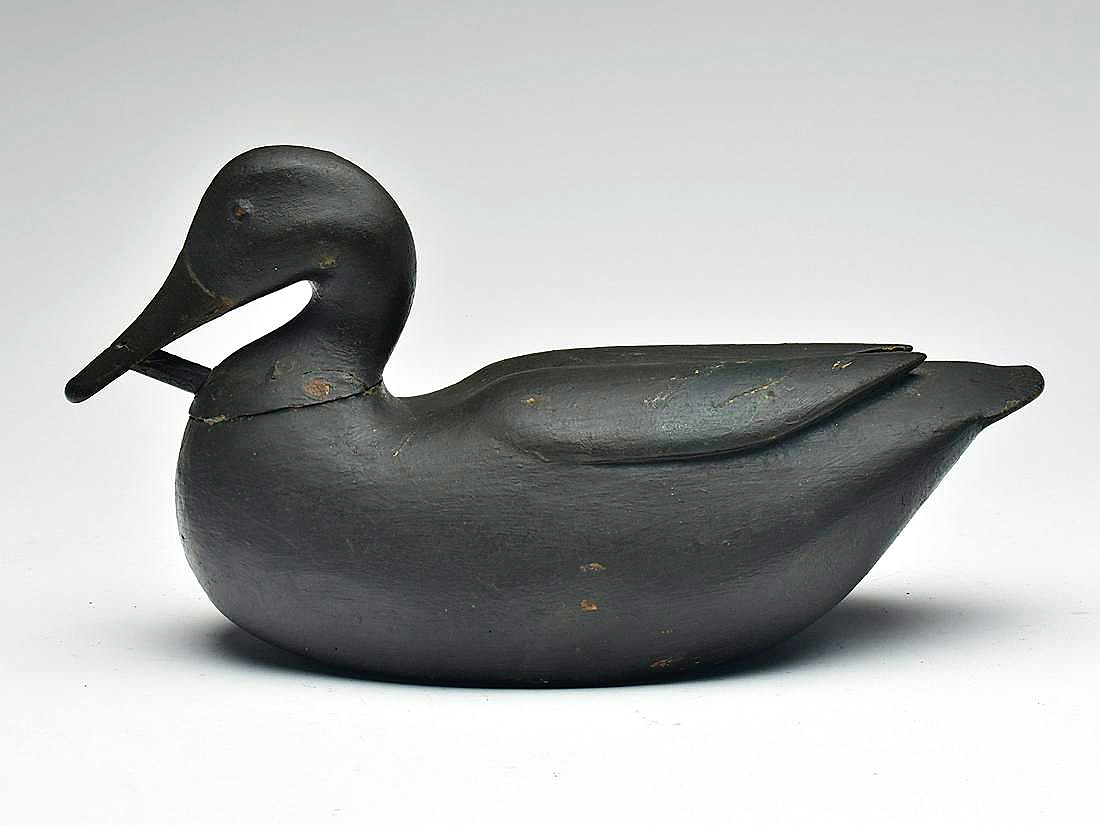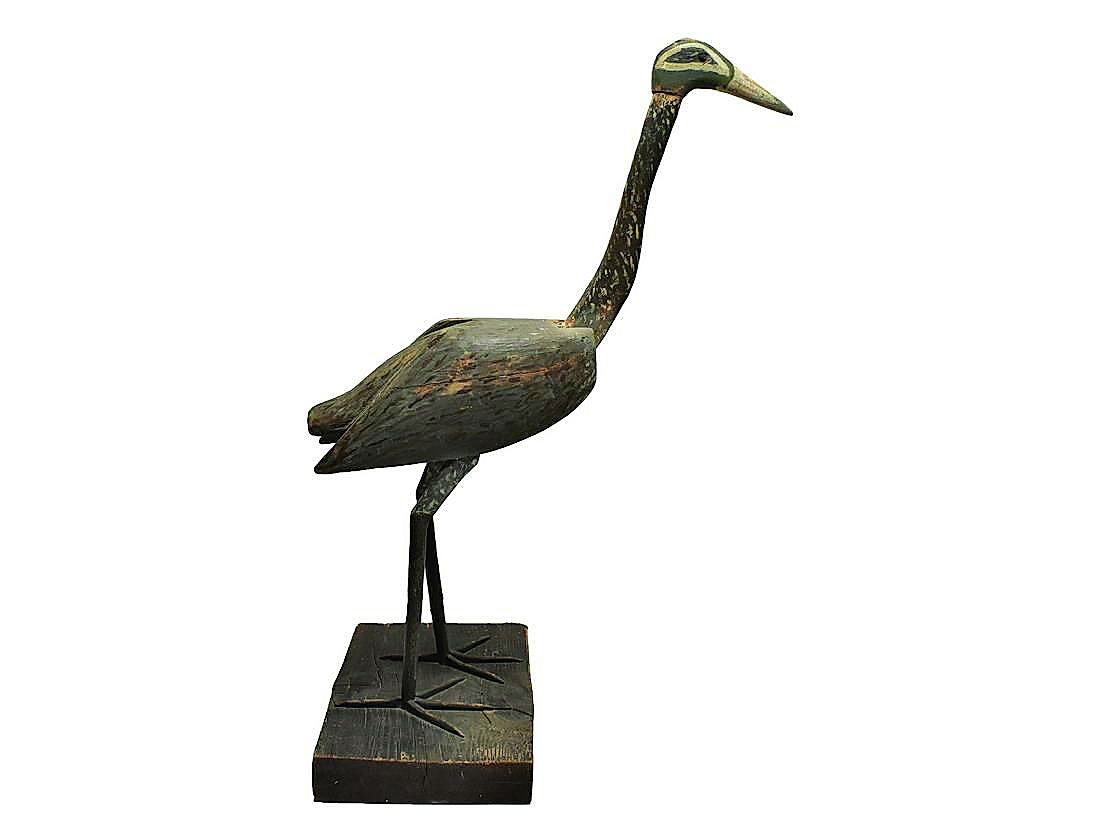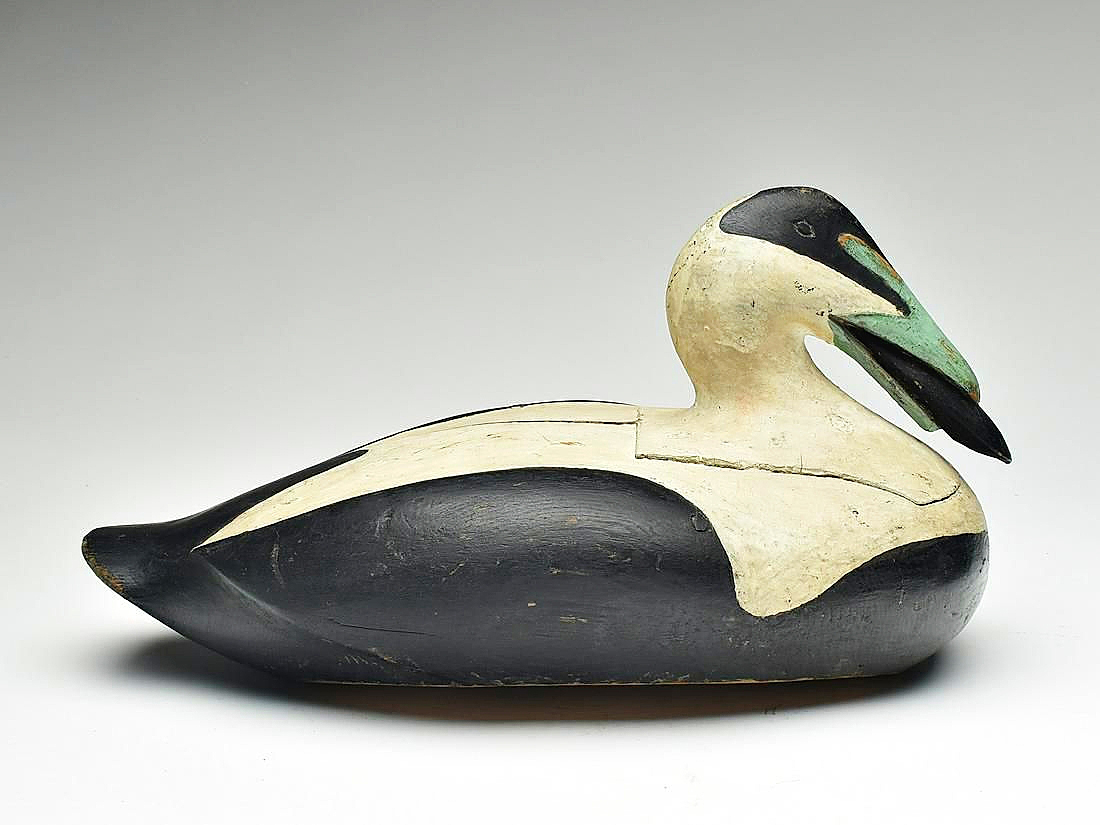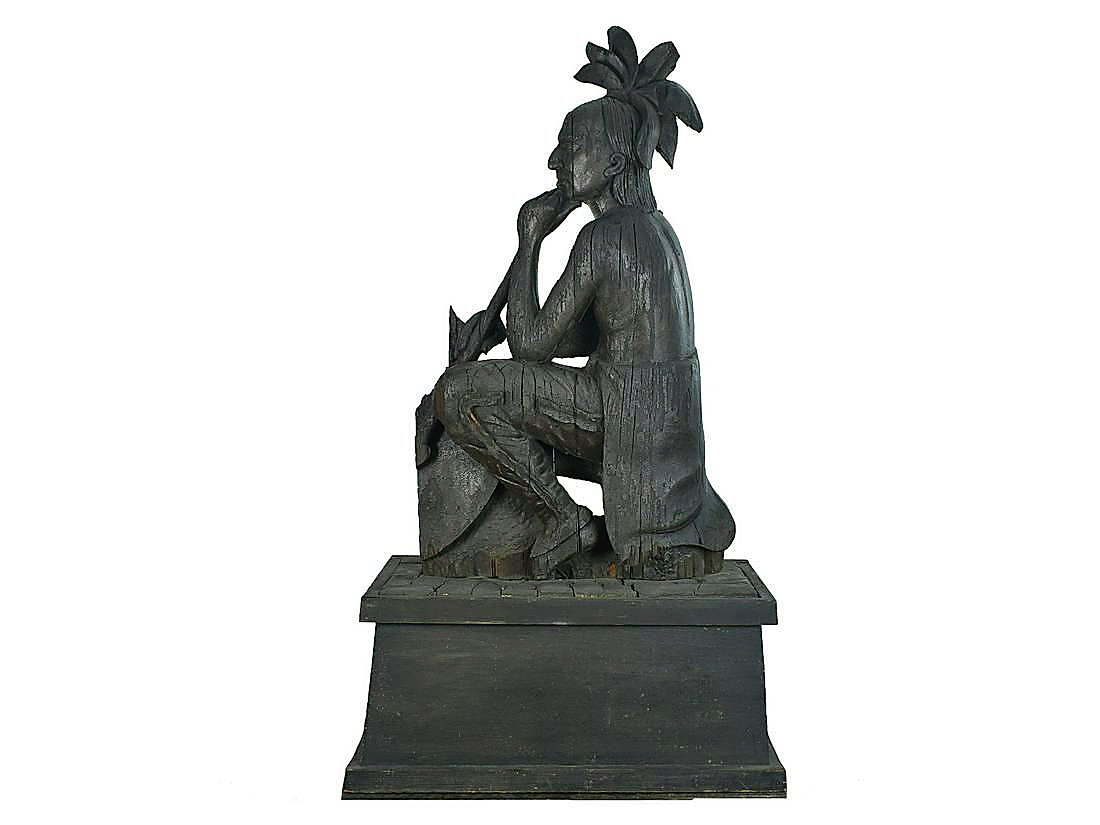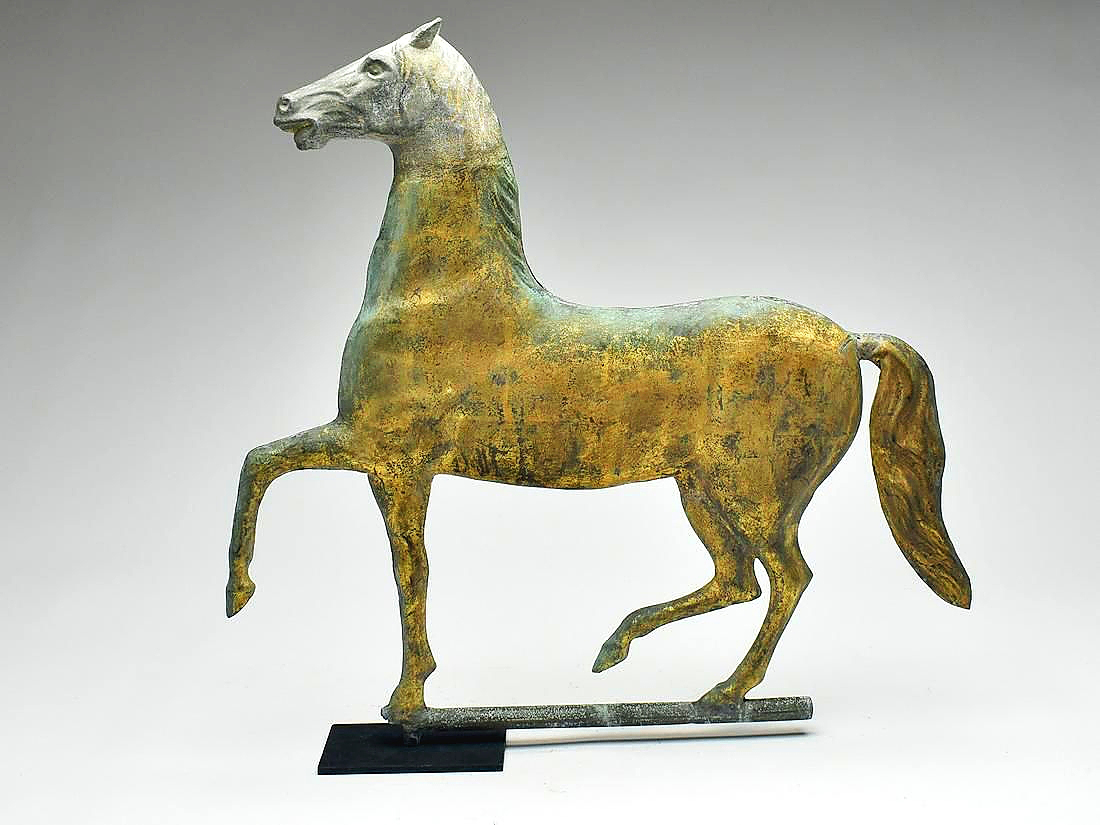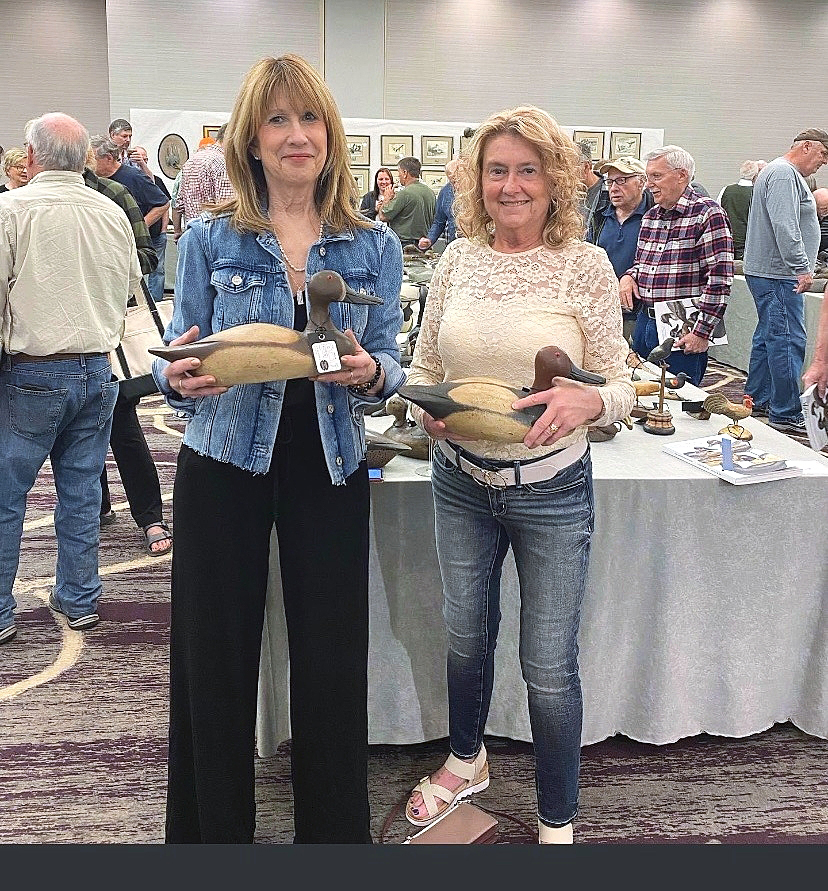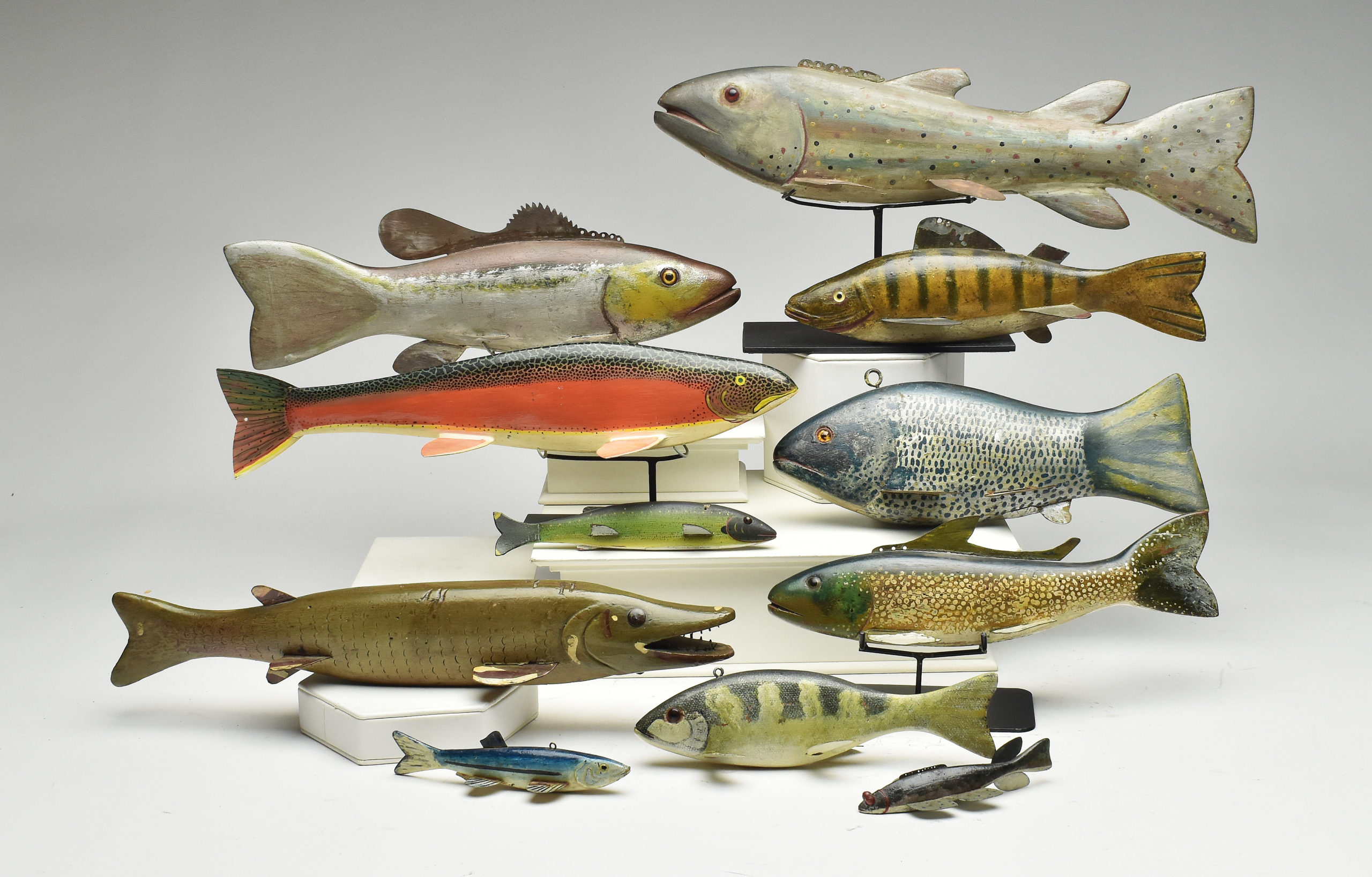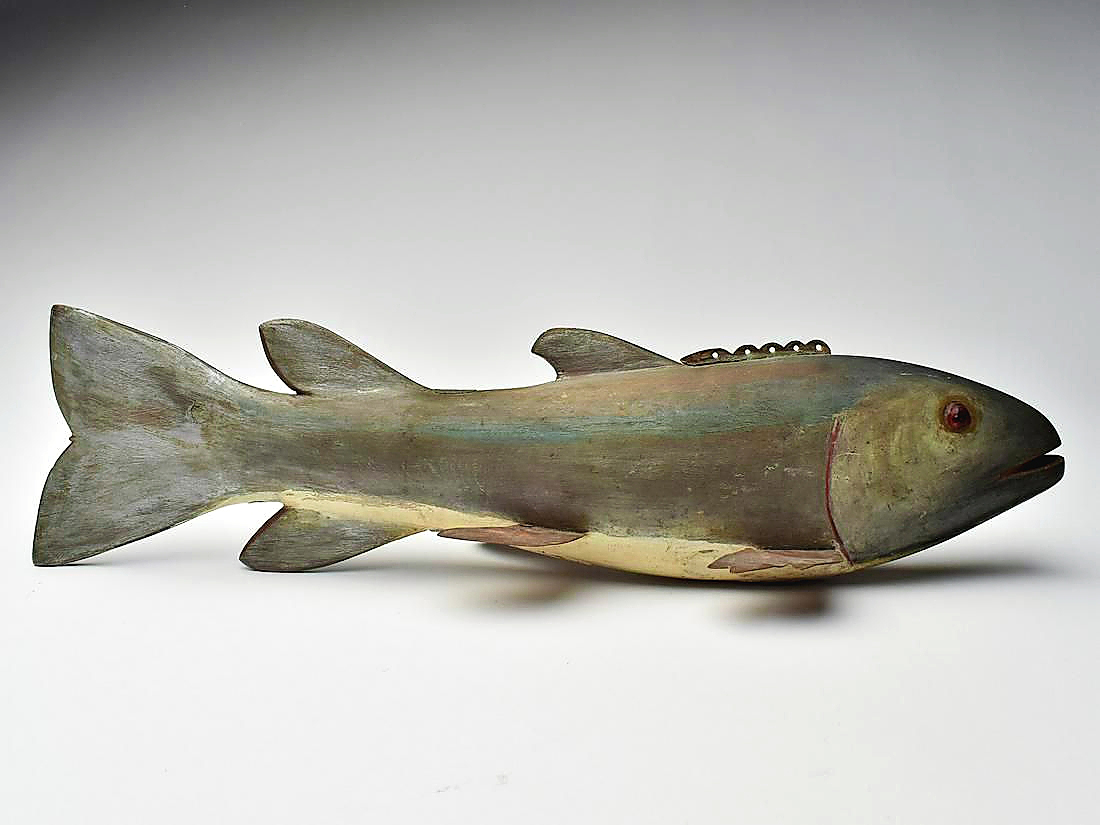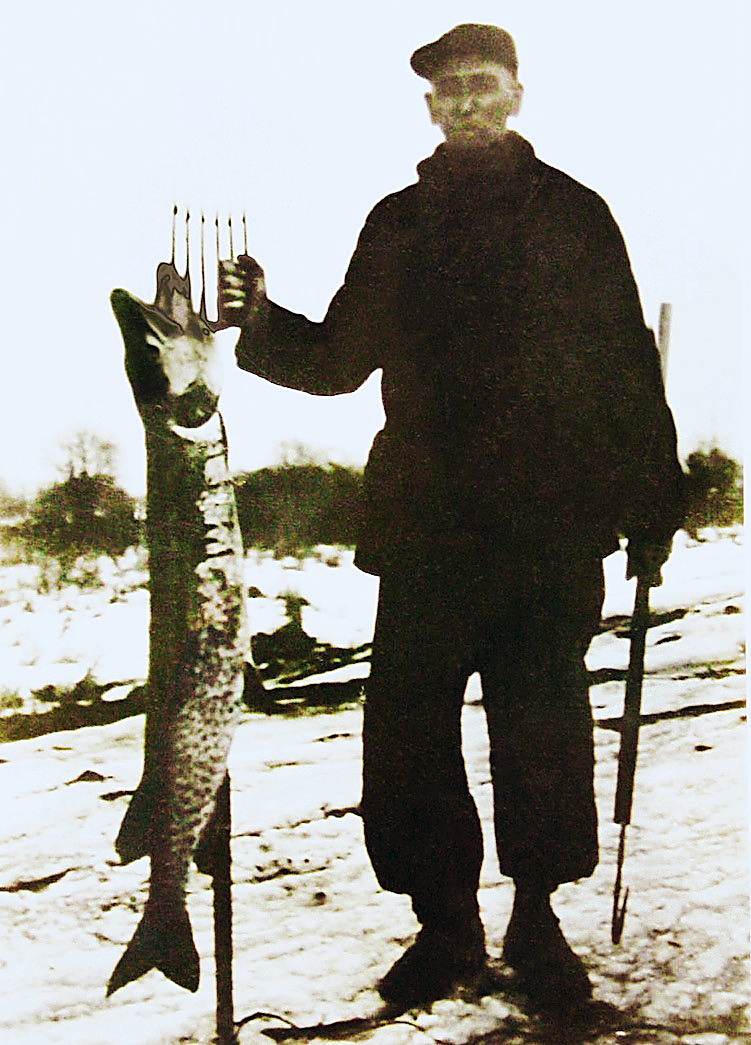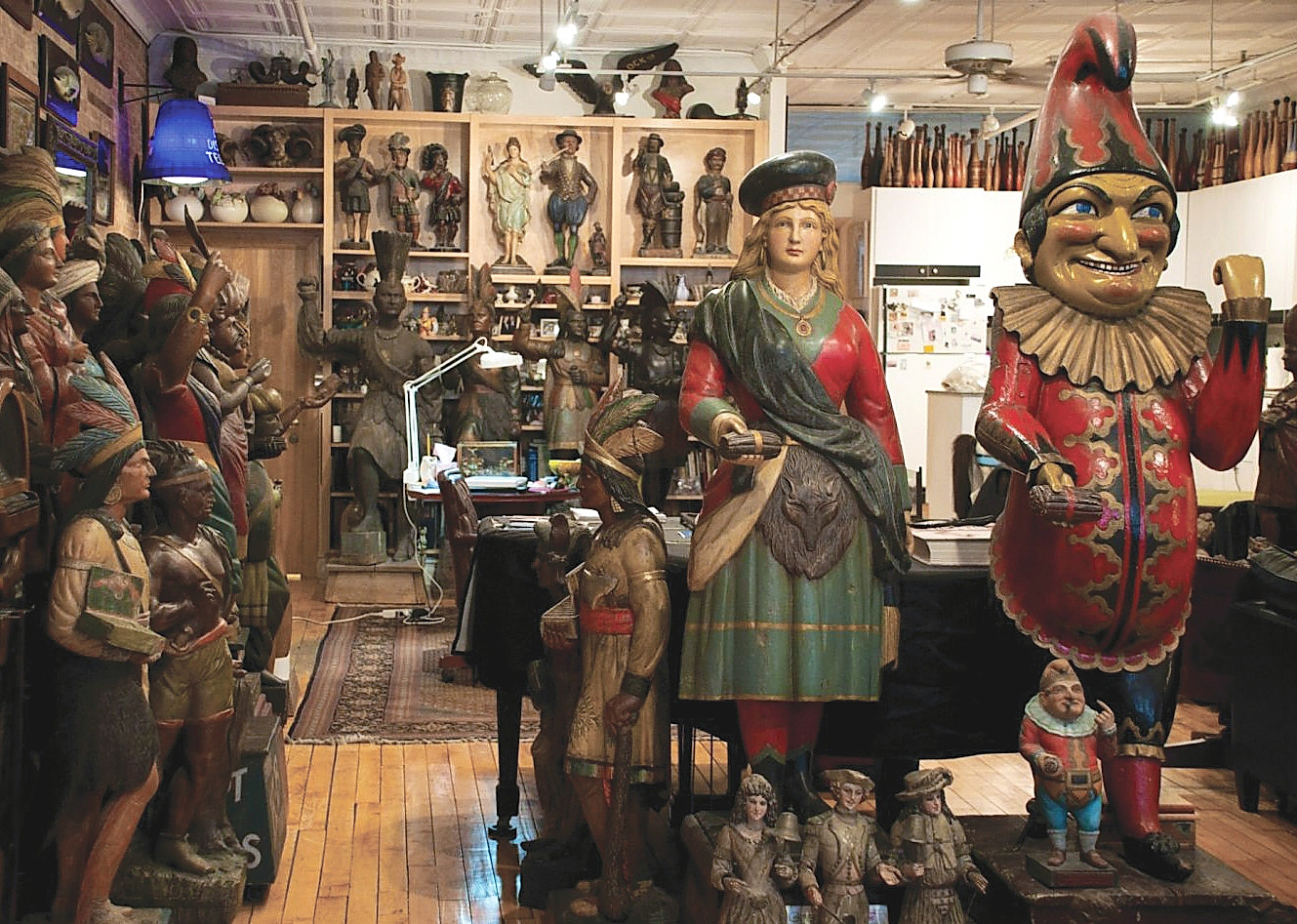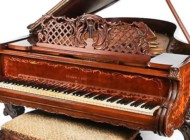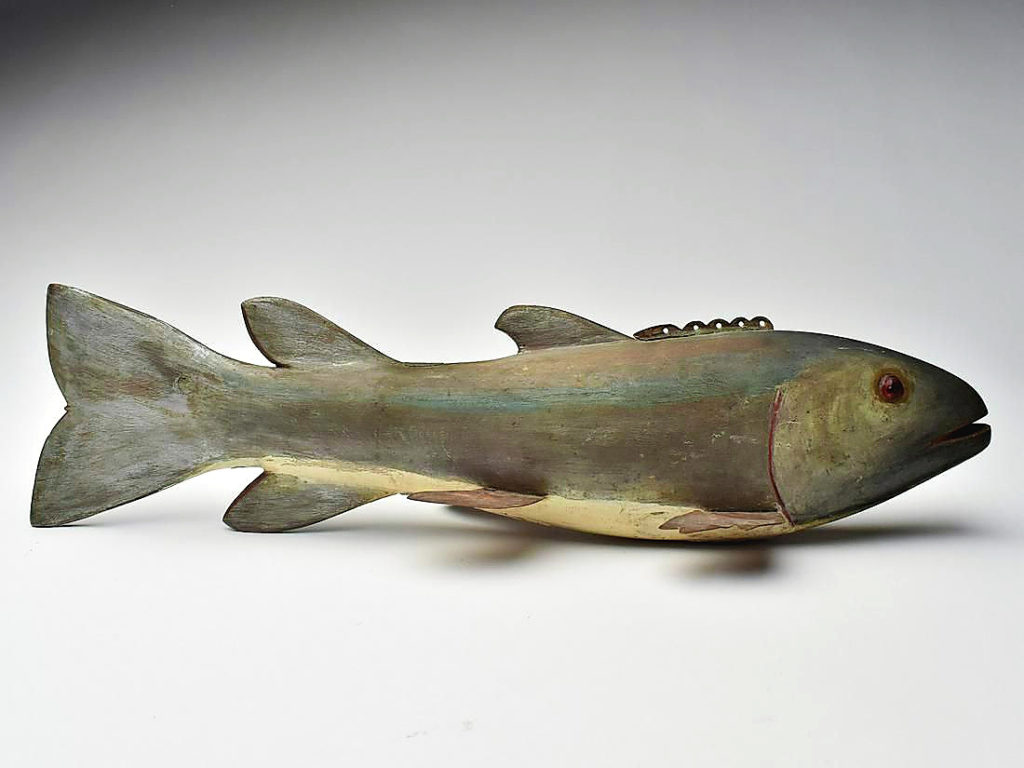
It was expected to be the star of the sale and met expectations. Cataloged as “the most magnificent fish decoy ever offered at auction,” it had been made by Hans Janner, measured more than 17 inches long and sold for $168,000, more than twice the estimate. It also set a new world record for a fish decoy.
Review By Rick Russack, Photos Courtesy Guyette & Deeter
LOMBARD, ILL. — Guyette & Deeter’s April 27-28 sale was held in conjunction with the North American Decoy Collectors Association Show, which describes itself as “the largest decoy and sporting collectibles show in North America” and attracts a huge crowd of visitors, many of whom were interested in what Guyette & Deeter were selling. The sale included nearly 600 lots and the full color, fully indexed, printed catalog featured more than 348 pages. It included numerous biographies of carvers and collectors, preserving much of the “lore” of decoy collecting. It’s a worthwhile addition to a collector’s library. When applicable, detailed provenance was included, and a guaranteed condition report was printed for each carving or decoy. The printed catalog contained extensive information, and many vintage photographs were not available in the online catalog. More than 80 items sold for more than $10,000 each and the auction achieved $3,750,000.
“A thousand years before the first American quilt was created, before the first weathervane showed the direction of the wind, before any of these things, fish decoys were actively being used for ice spearfishing by Native Americans. Men have spearfished for bass, sturgeon, muskellunge, carp, trout and other species.” So states the Guyette and Deeter catalog, quoting Beneath the Ice: The Art of the Spearfishing Decoy (1990), one of the first books on fish decoys. About 60 fish decoys were included in the sale; many came from the collection of George and Miriam Van Wallegham, one of the two major single-owner collections in the sale. The presale advertising heavily promoted the selection of fish decoys carved by masters, including Hans Janner, Ted Vandenbossche and Oscar Peterson. Four of them sold for more than $50,000 each. One Hans Janner fish was described in the catalog as “the most magnificent fish decoy ever offered at auction.”
Buyers apparently agreed with this assessment as it sold for $168,000, more than double the estimate and was not only the highest price of the two-day sale but set a new record for a fishing decoy. It was a large decoy, more than 17 inches long, with carved mouth and gills and had a total of four weights. The decorative painting featured tri-color dot painting extending from underneath the eye through the tail and had ghost fish decoration as a trout on one side. Hans Janner, (1880-1963) lived in Mount Clemens, Mich., and his decoys were used on Lake St Clair. In 1985, Janner’s son estimated that no more than 150 of his father’s decoys survive. Janner decoys have been included in several exhibitions, including one at the American Folk Art Museum in 1992. Janner used a hatchet to carve the basic form and then a drawknife. Most have multiple brass fins though this one had copper and wood ones. Other Janner fish decoys also did well. A 15-inch walleye decoy, carved from walnut with portions left natural, realized $84,000. Its mouth was highlighted in red and yellow and was used around the gills and tail. A 12-inch rock bass by Janner brought $69,000.
Ted Vandenbossche was another Mount Clemens carver, who, in the first half of the Twentieth Century, carved a 16-inch muskellunge which sold for $51,000. It had copper fins, painted tack eyes, and inserted metal teeth in an open mouth with carved gills and scales. Vandenbossche was a jack-of-all-trades who also farmed, ran a boat livery service, sold fishing tackle and bait, and rented ice fishing shanties. While it was expected that fish decoys would do well, there were some surprises, such as a 12-inch-long perch, cataloged as probably having its two front fins replaced, which sold for $44,400 against a high estimate of $6,000.
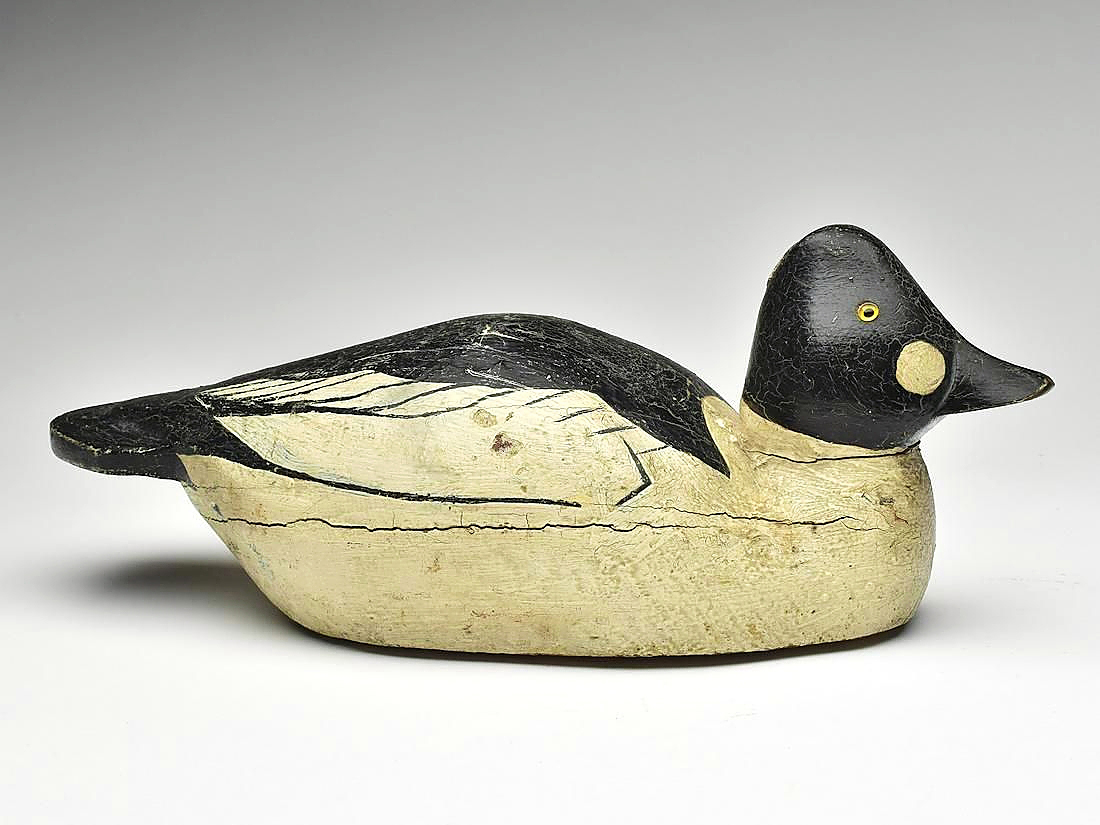
A folky “fat jaw” goldeneye made by the Ward brothers of Crisfield, Md., early in the Twentieth Century realized $60,000.
The Van Wallegham collection included fish decoys made by other Michigan carvers such as Ken Bruning, Andy Trombley, Isaac Goulette, Tom Schroeder and others. The collection was not limited to Michigan; it had several fish decoys used on Lake Chautauqua, in the Finger Lakes region of New York. From another consignor, a painted trout decoy by Harry Seymour brought $15,600. It had metal fins with a painted, scalloped leather tail and painted tack eyes with yellow decorated paint in front of a carved gill. A very unusual fish decoy by Seymour was carved with a face and head representing Seymour’s son Lucius. Probably a unique piece of folk art, it sold for $5,400.
The sale was built around the two major collections, each of which concentrated on regional decoys. George and Miriam Van Wallegham concentrated on working Michigan decoys and other folk art and the catalog has the story of how their collection came about. They had been collecting for about 60 years. The Herb Desch collection of Wisconsin decoys and those used along the Illinois river flyway was extensive and well-documented in the catalog. In addition to the 60 fish decoys, there were cigar store Indians, sporting art, working decoys by dozens of makers, decorative carvings, miniatures, Mason factory decoys, as well as carvings by the acknowledged masters — Elmer Crowell, the Ward Brothers, Charles Perdew, Gus Wilson, Frank Finney, Jim Schmiedlin, plus dozens more. Many of the carvings in this sale have been illustrated in books and articles.
Six working duck decoys sold for more than $50,000 each. Bringing $102,000, the highest priced duck decoy in the sale, was a rare black duck made by the Caines brothers of Georgetown, S.C. There were five brothers and it’s thought that they produced only a few hundred decoys, of which perhaps 50 are known today. This decoy was well-known to collectors, having been widely exhibited as well as described and pictured in Southern Decoys of Virginia and the Carolinas (written by Henry A. Fleckenstein in 1983 and the The Great Book of Wildfowl Decoys (ed Joe Engers, 2000). This black duck had deep relief wing carving, a reared-back head, tack eyes and incised tail feather carving. The area they lived in, Caines Village, was part of a large tract of land purchased by a wealthy businessman and statesman Bernard Baruch. Eventually four of the five brothers worked for him.

The preview was well attended, and this photo shows prospective bidders examining the duck decoys.
A rigmate pair of hollow-carved bluewing teal made in the late Nineteenth Century by Nate Quillen, Rockwood, Mich., sold for $81,000, the second highest priced of the duck decoys in the sale. The pair was from the Van Wallegham collection, and like the Caines brothers’ black duck, they had been illustrated and discussed in numerous publications. An unusual, folky, “fat jaw” goldeneye made by the Ward brothers of Crisfield, Md., in the early Twentieth Century realized $60,000. This bird had also been in the Van Wallegham collection and had also been included in books, including Adele Earnest’s The Art of the Decoy: American Bird Carvings (1997). Earning the same price, $60,000, was a greenwing teal, carved by Charles Bergman, Astoria, Ore. An outstanding mechanical owl decoy, with wings that could be made to flap, went out for $51,000. It had been made by Charles Perdew, Henry, Ill., and it is the only owl decoy Perdew is known to have made. Pheasant feathers had been applied around the glass eyes, bill, and neck and the wings flapped when a string was pulled.
Several of the Wisconsin decoys from the Herb Desch collection had a folky appearance and did well. A pair of canvasbacks, made by Gus Moak, Tustin, Wisc., in the early Twentieth Century sold for $26,400. A Canada goose by the same maker, which also appeared in books and articles, earned $6,600. Among other ways of earning a living, Moak was a market gunner. Perhaps he used his own canvasback decoys when hunting for the market: he was paid 10 cents for each canvasback he shot. The catalog notes that he reportedly “sold all the decoys he could make for $50-55 a dozen.” His decoys had a distinctive look with eyes placed higher on the head than most other makers. A pair of bluewing teal, made by Frank Resop, Berlin, Wis., in the Twentieth Century earned $14,400. One of the most sought-after Wisconsin decoys was a wood duck hen made by Ferd Homme, Stoughton, Wis.. He is believed to have produced only about 100 decoys and this example brought $30,000. It was also from the Van Wallegham collection and was the first lot sold on the first day of the auction.
Decorative and contemporary carvings have brought strong prices at recent decoy sales and they did so here. A wood duck drake dated 2008, made by Jim Schmiedlin, Bradfordwoods, Penn., and one of 11 by the maker in the sale, made $48,000. Its head was turned, it was reaching over a slightly raised right wing and very well painted. The sale featured a very unusual example by Frank Finney, Cape Charles, Va., some of whose carvings have sold for more than $20,000, as did this one which sold for $24,000. It depicted a frog resting on a group of water lilies, watching a dragonfly a short distance away on a lily flower. A 26-inch-long grasshopper by Finney brought $18,000 and a walking stick, carved with the heads of nine extinct species of birds reached $10,200. In all, there were 21 works by Finney and numerous other decorative carvings by other makers.
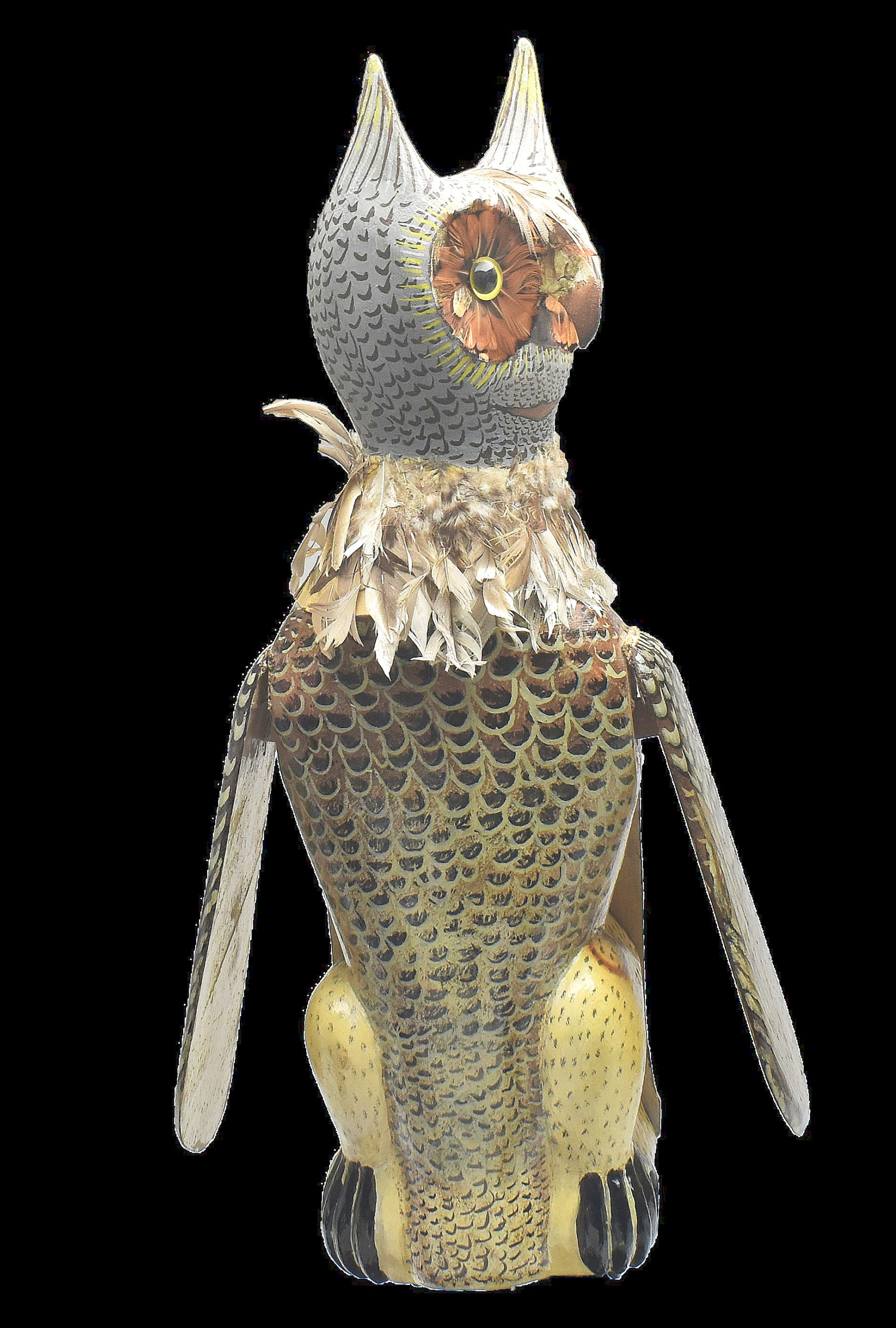
The wings of this owl decoy flapped when a string was pulled. With pheasant feathers, it is the only owl decoy made by Charles Perdew and it sold for $51,000.
While we’re discussing decorative carvings, we should say that there were more than 25 miniatures by a variety of carvers, including a selection of eight by Jess Blackstone (1909-1988), a carver who worked in Concord, N.H., and sold his carvings through stores operated by the League of New Hampshire Craftsmen. Prices for his birds ranged from $600 to more than $2,700.
There were more than 20 Mason factory decoys, topped by a premier grade pair of hollow-carved bluebills which sold for $12,000. The Mason shore birds included a circa 1900 willet which flew to $7,800. In addition, there were decoys made by the Evans Decoy Factory, Ladysmith, Wis. Prices ranged from $1,440 for a pair of mallards to $10,800 for a rare pair of bluewing teals.
After the sale, Jon Deeter said, “It was one of those sales where everyone was having a good time. There were about 200 people in the salesroom for most of the sale. Several people said to me that they were glad that it was a live sale and that they had the opportunity to chat with old friends; I like to hear that. The $168,000 Janner fish set a record for any fish decoy, and the $3.75 million gross was just a bit under our high estimate. The fish collectors knew the collections that they came from, and they recognized the rarity and quality of what was offered. It was one of those sales where everything went right. Transporting everything and everyone to Chicago for the sale is always an adventure but we’ve been doing it for years.”
The next sale is in August in Portsmouth N.H., during Antiques Week and will include the collections of Russ and Karen Goldberger, an important collection of paintings, including works by Winslow Homer, Mary Cassatt, George Bellows and others, along with a selection similar to that in this sale.
Prices quoted include the buyer’s premium as reported by the auction house. For information, www.guyetteanddeeter.com or 410-745-0485.

